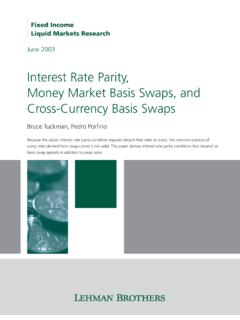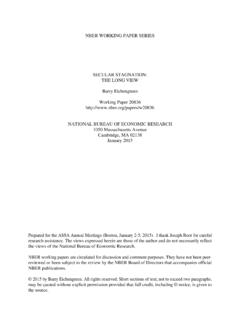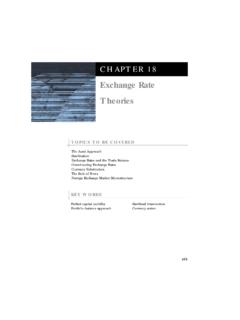Transcription of Interest Rate Options - Analytical Finance
1 Interest Rate OptionsSaurav SenApril 2001 Contents1. Caps and Defintions .. Plain Vanilla Caps .. Caplets .. Caps .. Bootstrapping the Forward Volatility Curve .. Caplet as a Put Option on a Zero-Coupon Bond .. Hedging Caps .. Floors .. Pricing and Hedging .. Put-Call Parity .. At-the-money (ATM) Caps and Floors .. Digital Caps .. Pricing .. Hedging .. Other Exotic Caps and Floors .. Knock-In Caps .. LIBOR Reset Caps .. Auto Caps .. Chooser Caps.
2 CMS Caps and Floors .. 92. Swap Swaps: A Brief Review of Essentials .. Swaptions .. Definitions .. Payoff Structure .. Pricing .. Put-Call Parity and Moneyness for Swaptions .. Hedging .. Constant Maturity Swaps .. Definition .. Pricing .. Approximate CMS Convexity Correction .. Pricing (continued) .. CMS Summary .. Other Swap Options .. LIBOR in Arrears Swaps .. Bermudan Swaptions .. Hybrid Structures .. 17 Appendix: The Black Model Specification.
3 Pricing Vanilla Calls .. Pricing Vanilla Puts .. Digital Call Pricing .. LIBOR-in-Arrears Calculations .. 201. Caps and DefintionsA cap is a call option on the future realisation of a given underlying LIBOR rate. Morespecifically, it is a collection (or strip) of caplets, each of which is a call option on theLIBOR level at a specified date in the future. Similarly, a floor is a strip of floorlets, eachof which is a put option on the LIBOR level at a given future date. Caps and floors arewidely traded OTC instruments.
4 As explained below, they provide protection against widelyfluctuating Interest rates a cap, for instance, is insurance against rising Interest rates . Capsand floors also reflect market views on the future volatility of LIBOR Plain Vanilla CapsIn this section, we discuss plain vanilla caps in further concreteness, suppose the underlying Interest rate is the maturity LIBOR. LetL(t, T, ) denote1the forward LIBOR at timetfor the accrual period [T, T+ ].The spotLIBOR at timeTis then, by definition,L(T, T, ).This rate fixes at timeT,and a dollarinvested at this rate pays 1+ L(T, T, ) at timeT+.
5 The maturity is expressed in termsof fractions of a year for example, = for the 3-month : InL(t,T, ),the first argument is current time, the second argument is the start date forthe accrual period, and the third argument is the length of the accrual CapletsAs mentioned earlier, a cap is a strip of caplets. The price of a cap is the sum of its constituentcaplet prices, and so we focus on these first. A caplet is a call option , acaplet with maturity dateTand strike rateKhas the following payoff: at timeT+ ,theholder of the caplet receives2 T= (L(T, T, ) K)+Note that the caplet expires at timeT,but the payoff is received at the end of the accrualperiod, at timeT+.
6 The payoff is day-count adjusted. The liabilites of the holderof this caplet are always bounded above by the strike rateK,and clearly if Interest ratesincrease, the value of the caplet increases, so that the holder benefits from rising the usual arguments, the price of this caplet is given by the discounted risk-adjustedexpected payoff. If{P(t, T) :T t}represents the observed term structure of zero-couponbond prices3at timet,then the price of the caplet is given by t= P(t, T+ ) Et[(L(T, T, ) K)+]In this equation4, the only random term is the future spot LIBOR,L(T, T, ).
7 The price ofthe caplet therefore depends on the distributional assumptions made onL(T, T, ).One ofthe standard models for this is the Black model, described in the appendix. According tothis model, for each maturityT,the risk-adjusted relative changes in the forward LIBORL(t, T, ) are normally distributed with specified constant volatility T, (t, T, )L(t, T, )= Td W(t)As shown in the appendix, this implies a lognormal distribution forL(T, T, ),and underthis modelling assumption the price of theT maturity caplet is given by t= P(t, T+ ){L(t, T, )N(dT1) KN(dT2)}wheredT1,2=log (L(t, T, )/K) 12 2T(T t) T T tandN(z) =1 2 z e 12u2du2 Notation:x+= max{x,0}={xifx>00 ifx 03 Notation.}
8 InP(t,T),trepresents current time andTis maturity date. A dollar at timeTis worthP(t,T) dollars at : Et[.] is the expectation operator, conditioned on all information at timet,hence the subscript,and computed using the risk-adjusted probabilities P,hence the CapsTo construct a standard cap on the maturity LIBOR with strikeKand maturityT,weproceed as follows. Suppose the current time withT,we proceed backwards insteps of length ,and letnbe the number of complete periods of length , we get a set of timesT0=t+ ; < T1=T0+ T2=T1+ =T0+ 2.
9 Tn=T=T0+n We then construct a portfolio ofncaplets, struck atK,with maturities{T0, T1, .., Tn 1}.These are called the fixing dates or caplet maturity dates. The dates{T1, T2, .., Tn}arecalled payment dates. The cap is then just equal to this strip of price of a cap is equal to the price of its constituent caplets. If i(t) denotes the priceat timetof a caplet with maturity dateTi(and payment dateTi+ ), then the price of thecap is (t, T) =n 1 i=0 i(t) =n 1 i=0 P(t, Ti+1)[L(t, Ti, )N(dTi1) KN(dTi2)]The only quantity that cannot be directly observed in this pricing formula is the set offorward rate volatilities, (t, T) = (t, T; T0, T1.)
10 , Tn 1)and a given set of forward rate volatilities produces a unique price. If we can find a singlenumber such that (t, T) = (t, T; T0, T1, .., Tn 1)= (t, T; , , .., )then this is called the implied or Black volatility for theT maturity cap. The observedprices of caps of various maturities are inverted numerically to obtain a term structure ofBlack volatilities, and these implied volatilites are quoted on the Bootstrapping the Forward Volatility CurveThe forward volatility curve describes information about individual caplet volatilities con-tained in the term structure of implied cap volatilities.












